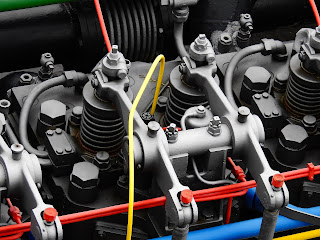A diesel engine is an engine where the fuel is burned inside the core part of the engine such as the cylinders where power is generated. This is also called internal combustion engine. In a diesel engine, the fuel burns inside the cylinders themselves. There is no need to flow heat from where it's generated into the cylinder in internal combustion engine. Therefore, the wastage of energy in internal combustion engine is very little. Here, everything happens in the same place. For this reason, internal combustion engines are more efficient than external combustion engines. By utilizing same amount of fuel, more energy is produced in internal combustion engine.
Difference between a diesel engine and a gasoline engine
Both diesel and gasoline engines work on the principle of internal combustion, but in little bit different methods. Air and fuel are injected into small metal cylinders in the case of a gasoline engine. A piston compresses the mixture which creates it explosive and a small electric spark from a sparking plug sets fire to it. It creates the mixture explode and generates power which pushes the piston down the cylinder and through the crankshaft and gears turns the wheels.
On the other hand, in the case of a diesel engine, air enters first into the cylinder and the piston compresses it more than a gasoline engine in terms of volume. Air-fuel mixture is compressed with less volume of its original volume in a gasoline engine. Air is compressed more volumes than a gasoline engine in the case of a diesel engine. For example, we can say about pumping a bicycle tire. In this case, our hands became hotter due to increase of the heat during pumping the bicycle tire. For this reason, compressing a gas generates heat. After compressing the air, a mist of fuel is sprayed into the cylinder usually in a modern engine by an electronic fuel-injection system, which works quite similarly like a sophisticated aerosol can. The amount of fuel injected depends on how much power the driver wants the engine to generate. Because of hot air, the fuel instantly ignites and explodes without any requirement of a spark plug. This controlled explosion causes the piston push back out of the cylinder, generating the power that drives the vehicle or machine in which the engine is mounted. When the piston goes back into the cylinder, the exhaust gases are pushed out through an exhaust valve and, the process repeats itself.
How a diesel engine turns fuel into power?
Two Stroke Engine:
Here, the piston moves up and down just once and after then the complete cycle is done. There are three stages in a two-stroke cycle:
- Exhaust and intake: Fresh air is blown into the side of the cylinder, pushing the old exhaust out through valves at the top.
- Compression: When the inlet and exhaust valves close, the piston moves up, compresses the air, and became hot. After reaching the top of the cylinder by the piston, fuel is injected and impulsively ignites.
- Power: When the air-fuel mixture ignites, it pushes the piston down and drive the crankshaft which generates power to turn wheels.
Four Stroke Engine:
Same like a gasoline engine, a diesel engine typically runs by repeating a cycle of four stages or strokes, during which the piston moves up and down twice during the cycle. That is the crankshaft rotates twice.
- Intake: When the piston moves down, air enters into the cylinder via the open air inlet valve.
- Compression: When the piston moves up, the inlet valve closes and compresses the air mixture, then it became hot. Fuel is injected into the hot gas via the central fuel injection valve and impulsively ignites. In this case, there is no requirement of sparking plug.
- Power: When the air-fuel mixture ignites and burns, it pushes the piston down and drives the crankshaft which generates power to rotate wheels.
- Exhaust: The exhaust gases go out when the outlet valve is open, pushed out by the returning piston.
Comparison between Two Stroke and Four Stroke Engine
In comparison to four stroke engines, two stroke engines are comparatively lighter, smaller and tend to be more efficient than four stroke engines. In a four stroke engine, power is generated during every two rotations which requires cooling and lubrication and causes higher wear and tear. On the other hand, in a two stroke engine, power is generated once during each rotation which tend to be more efficient than a four stroke engine.
Why diesel engines are more efficient?
In comparison, diesel engines are more efficient than gasoline engines. According to Carnot's rule, the efficiency of an engine depends on the high and low temperatures between which it operates. In the case of a diesel engine, it compresses more and operate at higher temperatures. A Diesel engine became more efficient when it cycles through a bigger temperature difference. That is a higher hottest temperature or a lowest colder temperature. In a diesel engine, the fuel burn hotter and more completely, releasing more energy. On the other hand, in a gasoline engine, more fuel (or less air) are required to provide to the cylinder in order to keep it working. As diesel has a higher energy density than gasoline, diesel fuel carries slightly more energy per gallon than gasoline. Moreover, diesel is a better lubricant than gasoline which helps a diesel engine to run will naturally with little friction.
